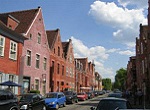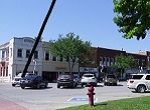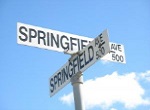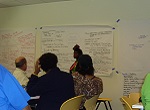How Neighborhood Demographics Affect Housing and Service Needs
Last Updated: September 4, 2023
Neighborhood demographics are the data describing population characteristics of the folks that live in your community. Typically such numbers are important for grant applications, long-range planning, market research for businesses, trend analysis over time, and comparisons of places.
It seems a shame to spend good money on an empty playground, as seen on this page and in many neighborhoods.
So it's appropriate for you community leaders to understand something about who
lives in the community, whether your setting is suburban, urban, or
rural. Knowing the total population may be interesting, but more and more, the providers of goods and services need detailed information. You do too.
For instance, if your
subdivision or neighborhood is full of kids right now, it will fall silent in about 15 years unless you keep bringing in new residents.
It's not necessarily disastrous to have no children around, but it highlights different community needs if your schools are virtually empty but you don't have a senior center yet.
Beyond this practical example, demographic data can be hugely important in framing your argument for systematic changes in racial equity and community development, concentrated poverty, environmental justice, and group disparities in health outcomes.
Where to Obtain Neighborhood Demographics Data

In general, the major source of neighborhood demographics information for the U.S. is the Census Bureau. The results of the 2020 Census are available on-line, as we describe in the following sections. We have to apologize that every link in this section serves as only the most general introduction, but at least we try to steer you toward a page that would tell you if the data you seek is even available.
You can compare the 2020 results with the 2010 Census, which is a significant exercise in understanding neighborhood change.
Do this now. By 2027, for instance, the Census numbers may or may not be still pretty reliable for your community. If you know your population numbers and characteristics to be changing significantly, you will need to take those 2020 results with a grain of salt. Depending on your purpose, it may be worth the effort to make estimates of the changes using locally available school, utility, or significant employer data.
Other countries will have a government office that collects population information and estimates. The United Nations does so internationally.
Nonprofit groups sometimes package Census data in particular ways to enable organizations, advocates, and foundations to tell a story. An example is the annual Kids Count compilation of state-level data by the Annie E. Casey Foundation.
Private businesses also collect, package, and sell information that is particularly relevant to other businesses and your local economic development efforts. If you need specialized information, sometimes categorized into groups with cute names, it may be worthwhile to pay for that information.
But we believe that most community groups should start with the basic government sources and purchase neighborhood demographics information only in rare instances when they have a very particular and targeted need.
If you live in a city or town large enough to have a planning department office, make that your first stop if you need help. Not only will they be familiar with how to find the neighborhood demographics data you want, but also they also could help you make generalizations and interpretations about it.
If there's no planning department, a public library is another possible source. If you have an extension agent, they should be able to assist you both with finding and understanding data as well.
What to Expect from Census Data
The Census Bureau not only allows you to view data, but also provides a number of opportunities to create specific tables showing only the neighborhood demographics you want for the geographies you want.
Our experience as planners is that most groups that we work with are enjoying the transition to one supposedly unified source of Census information found on data.census.gov described in this resource page. American Fact Finder was discontinued in 2020. However, the Current Population Survey continues, and it provides monthly labor force statistics, as well as data on such disparate subjects as school enrollment, volunteerism, health insurance coverage, and child support.
The American Community Survey of the Census Bureau is conducted annually, using a sample of housing units. It provides one-year- and five-year estimates on a huge variety of population and housing characteristics, as detailed on page 10 of their ACS information guide. Also in that pdf file, read page 11 carefully to begin to figure out if the American Community Survey can show you data at the geographic level of interest. This source may or may not be helpful to you, depending on whether what you consider your neighborhood or community coincides with census tracts.
If you've been a neighborhood leader for a long time, you will notice that the American Community Survey replaced the "long form" of the Census with detailed periodic surveys not necessarily geared to the 10-year cycle.
As part of the ACS, the Census Bureau annually estimates migration into and out of states and counties. Start here to understand immigration flows. These become important when you want to compare your own neighborhood demographics with those larger areas to see how to evaluate your own numbers.
Even more importantly, the Bureau also makes state and county level population estimates; we suggest that you start with the methodology page here.
For privacy reasons the Census Bureau often suppresses particular
neighborhood demographics that may be of interest to your group,
especially at the block level. You'll find it impossible to calculate
exactly how much money your next door neighbor makes, for instance.
But you can learn many patterns about age, gender, who's moving into your neighborhood, income, housing age, household composition, and race and ethnic background.
Census Bureau procedures have changed considerably over the last 20 years, so if you had been familiar with the old paper reports, you might have to update yourself on the sophisticated new web-based material and its limitations.
The American Housing Survey now is updated every odd year on a national basis. In 2015 the Census Bureau started a new system of rotating how they collect data on metropolitan areas. Suffice it to say that if you want data for small metros down through rural America, you won't find it here. But if you are in a large urban area, start with this American Housing Survey introductory page. You will find typical housing information, but also some intriguing data on housing costs, mortgages, payment delinquency, home improvements, disabilities, and wildfire risk.
Is the Census Accurate?
Many people question the accuracy of the Census, citing personal examples or anecdotes about deliberate deceptions, especially by people who are in the country illegally or ethnic groups suspicious of government, or accidental undercounts or other errors. In truth, in most neighborhoods the Census is quite accurate and perfectly adequate for most planning purposes. There is always a local census review committee in a community of any size, and an effective committee improves the quality of the information by pointing out to the Bureau when the numbers seem unexpected and probably inaccurate.
If you are particularly interested in minority and low-income communities, many advocates will argue that these are the folks who are undercounted in the Census. Extreme mobility, homelessness, and fear of the immigration agents also may cause undercounting or inaccuracies in your neighborhood demographics.
A bit of rebelliousness on the part of libertarian or conservative folks in not returning their Census forms, no matter how often they are asked to do so, may or may not be affecting results in your location, so consider this factor. Because of the pandemic during the 2020 Census collection period, also impacting other Census Bureau products, it is difficult to assess how much this has skewed results.
I think it's fair to say that the Census Bureau is somewhat in flux right now, as they adapt admirably in many instances to the electronic revolution. But skyrocketing costs of manual data collection and increasing resistance to compliance have challenged their traditional ways of collecting data.
Other Sources of Demographic Data
You also can collect your own useful information, you know, as detailed on the neighborhood planning and housing condition survey pages.
Annual population estimates or other neighborhood demographics in smaller towns and cities often must be estimated using local school, utility, and housing move-in information that can be obtained sometimes from utilities or from occupancy permits, if you use such a thing.
The Internal Revenue Service provides information on estimated number
of households, population, gross income, wage and salary groups, and investment income in a zip code. This alternative to Census Bureau products shows annual data for the last 10 years. Begin with the individual income tax zip code data page.
The Office of Immigration Services in the U.S. Department of Homeland Security tracks immigration data by state. (If you need to understand this, see this introduction.)
For income-related and employment data, the authority is the Bureau of Economic Analysis, a division of the U.S. Department of Commerce. Use of this information in detail to determine your area's economic base is described on this website's economic base and location quotient pages.
The Department of Housing and Urban Development estimates metro area median incomes when determining some of its housing program income requirements. Social Security Administration data can help you estimate income for the self-employed, which doesn't show up for you in the older economic metrics from the government. And the Economic Research Service of the U.S. Department of Agriculture has some great chart-making and map-making capabilities for those in more rural areas. The Federal Reserve collects data on housing finance. On and on it goes.
A very important check on Census data is U.S. Postal Service information on number of households having mail delivery. Comparing their number to the Census number could help you spot any undercount problem you may have had. We would suggest starting with the USPS data overview page.
We could make our long list even more cumbersome, but just use your search engine to discover more if we didn't touch on a subject. You can determine commuting times (called journey to work), people before the official poverty level, cost of living in various cities including yours, sales prices of houses and rental costs, and computed data, such as housing affordability, which would be a combination of those housing purchase prices, rental costs, and income.
Another word of advice is that if you come close to the statistic you want to see, but you can't manipulate the charts, contact the relevant government office to see if they can run a chart for you. If you represent a genuine nonprofit organization or local government, they will help if you reach the right person.
Housing characteristics technically wouldn't be considered part of neighborhood demographics, in case you're wondering. But most groups use the same information sources on housing at about the same time they are studying neighborhood demographics. So we have been mentioning the housing data for your convenience. Your local real estate board may or may not be helpful in providing information on housing values, characteristics, and trends, but if not, we have had good success in enlisting a sympathetic real estate agent active in your neighborhood to do some research for you. Real estate professionals don't seem nearly as arrogant about their data as they once were.
Straying even further from what is often considered demographics, we believe that you have every right to see neighborhood-level crime data and to demand that police and your local government in general report truthful numbers to you, regardless of a city's desire to present itself as crime-free.
You also may find information from talented and careful bloggers or other online media. A developing trend is called hyperlocal media, where trained or
untrained journalists may cover an underreported geographic area. Many experiments along these lines are occurring, so keep an eye out for non-traditional investigative reporting. These reports may or may not rise to the level of useful social science data, but if these media are willing to disclose their methods and assumptions to you, you can evaluate them just as you make judgments about possible defects in well-established sources such as the census.
If your population is active online, you can try online surveys to determine detailed population characteristics, providing you have a piece or two of hard data to enable you to judge what percentage of people in the neighborhood have returned the survey. You'll find various survey platforms that cost little to nothing to use.
To obtain traffic counts, ask the government that controls the road--the state department of transportation for federal or state roads, or a county, municipal, or township organization, depending on who built and owns the road. If you don't know, ask one level of government and they can refer you to the right entity.
Be prepared for the transportation provider not to have the traffic count you want. You can ask them to install a traffic counting device temporarily, but many of them have more requests than they can accommodate.
Even considering all these sources, it's certainly possible that you may not find exactly the information you'd like for exactly the geographic configuration that you need.
What to Do with These Neighborhood Statistics
When I was a municipal planner, the typical experience before prevalent internet usage was that when a neighborhood leader would come to obtain Census tables, they would leave with 20 or 25 pages of material. Then about a week later the panicked phone call would come. The essence would be "but what does this all mean?"
Here are the questions to ask when you have lots of data and not too much experience in "reading" and understanding it:
• Over time, is this number going up or down? (Remember when obtaining Census data to try to find comparable data for 10 years earlier, or one year earlier if you’re using annual estimates. Even longer comparisons may be useful to show trends.)
• Compared to my entire city, is my neighborhood higher or lower? By what percentage? What about the comparison of my neighborhood to my entire metropolitan region?
• Compared to my state, is my neighborhood higher or lower? How about the nation?
• If you're looking at block-level data, how do the various blocks in your neighborhood compare to one another? What factors account for this? Are there dormitories, prisons, nursing homes, group homes, religious institutions, or other "out of sight, out of mind" groups living in your community that are skewing the numbers?
• How are we doing on key neighborhood demographics indicators?
Let's list some important factors you might look for:
1. An aging population is important to note for the neighborhood. This gives information not only about the possible needs of current residents, but also about when housing in the neighborhood is likely to begin turning over at a faster rate than is occurring now.
2. Generally a high percentage of home ownership as compared to a high number of renters is a good thing, as owners typically have more emotional and financial investment in the neighborhood.
3. Are the people who moved in during the last 10 years significantly different in any demographic characteristic from the people who have lived in the neighborhood for more than 20 years? If so, you know where you're headed.
Determine if you like that future or not, and what predictions your local business community should be making about the neighborhood demographics trends.
4. Will your housing stock accommodate the size and composition of families that are moving in? Are your houses too big, because now most of your people are "empty nesters"? If so, we predict an exodus the next time energy costs spike.
5. Will your school district be thinking of closing schools because there are no little kids? If so, what’s your game plan (temporary or permanent) for school site selection and recycling buildings formerly used as schools?
6. Are wages and other income staying stagnant over the years? If so, how can your community counteract what will no doubt be deferred housing maintenance?
7. Are you finding a significant number of children living with the grandparents or with single parents? How is that relevant to programming your local parks department or library?
8. If people are moving away faster than they move in, where are they going? What does that tell you about their incomes, household sizes, tastes in housing, job market, or journey to work?
These are some examples of what you might learn if you get one of the numbers crunchers in your organization to take a look at population, income, and housing characteristics. We wandered a little beyond demographics here and there, but you need to be aware of all these possible measurements relevant to your neighborhood or small city or town.
Correct application of the data is important in deciding the next steps for your neighborhood, or in practical steps such as writing winning community development grant narratives. If you need help in interpreting the data that you see, ask a nearby person affiliated with a university, such as an extension agent.
If you have a professional or very motivated amateur living in your neighborhood, one source of free historical data based on the U.S. Census is the National Historical Geographic Information System run by the Minnesota Population Center at the University of Minnesota. They provide downloadable data to enable historical comparisons using Census information. This source requires considerable sifting out of information irrelevant to your neighborhood, but it can be worth it. Their system also allows linking up to the geographic information system program to produce maps. Check this out if you are producing a neighborhood plan or preparing a grant application for a significant amount of money.
Another interesting tool is using the Google Maps Streetview feature of seeing previous Streetviews. Obviously this will grow in importance as the Streetviews history lengthens. Here's an introductory how-to article.
In the very near future, we see the technological potential to use geolocation data from cell phones, geographic information systems (computerized mapping, usually written simply as GIS), sensors mounted on light poles or buildings, and autonomous vehicle usage patterns to support your neighborhood's need to know. The question will be where each culture or each neighborhood will draw the line between privacy and data needs or wishes.
Now it's time for you to start checking out some of these information sources. If you get lost along the way, despite our efforts to start you on a page that will actually tell you whether you are likely to find the data you want at a geographic level you need, feel free to contact us. Also you may well want to read more on this website about related topics as shown below.
You Will Want to Read These Other Pages
- Making and Keeping a Good Community ›
- City Planning › Neighborhood Demographics
Join GOOD COMMUNITY PLUS, which provides you monthly with short features or tips about timely topics for neighborhoods, towns and cities, community organizations, and rural or small town environments. Unsubscribe any time. Give it a try.




